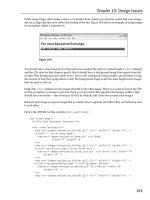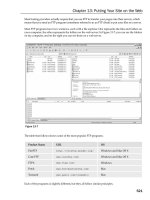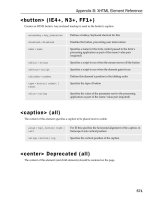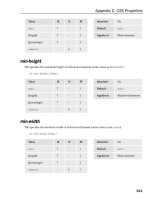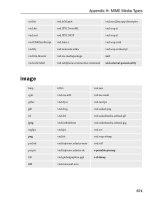Physique, Fitness, and Performance - Second Edition ppt
Bạn đang xem bản rút gọn của tài liệu. Xem và tải ngay bản đầy đủ của tài liệu tại đây (7.51 MB, 250 trang )
Half Title Page
Second Edition
Physique,
Fitness,
and
Performance
9197_C000.fm Page i Friday, May 18, 2007 9:54 AM
9197_C000.fm Page ii Friday, May 18, 2007 9:54 AM
Title Page
CRC Press is an imprint of the
Taylor & Francis Group, an informa business
Boca Raton London New York
Second Edition
Physique,
Fitness,
and
Performance
Thomas Battinelli, Ed.D.
Professor Emeritus
Exercise and Sport Science
Fitchburg State College
Fitchburg, Massachusetts
9197_C000.fm Page iii Friday, May 18, 2007 9:54 AM
CRC Press
Taylor & Francis Group
6000 Broken Sound Parkway NW, Suite 300
Boca Raton, FL 33487-2742
© 2007 by Taylor & Francis Group, LLC
CRC Press is an imprint of Taylor & Francis Group, an Informa business
No claim to original U.S. Government works
Printed in the United States of America on acid-free paper
10 9 8 7 6 5 4 3 2 1
International Standard Book Number-10: 0-8493-9197-0 (Hardcover)
International Standard Book Number-13: 978-0-8493-9197-2 (Hardcover)
is book contains information obtained from authentic and highly regarded sources. Reprinted
material is quoted with permission, and sources are indicated. A wide variety of references are
listed. Reasonable efforts have been made to publish reliable data and information, but the author
and the publisher cannot assume responsibility for the validity of all materials or for the conse-
quences of their use.
No part of this book may be reprinted, reproduced, transmitted, or utilized in any form by any
electronic, mechanical, or other means, now known or hereafter invented, including photocopying,
microfilming, and recording, or in any information storage or retrieval system, without written
permission from the publishers.
For permission to photocopy or use material electronically from this work, please access www.
copyright.com ( or contact the Copyright Clearance Center, Inc. (CCC)
222 Rosewood Drive, Danvers, MA 01923, 978-750-8400. CCC is a not-for-profit organization that
provides licenses and registration for a variety of users. For organizations that have been granted a
photocopy license by the CCC, a separate system of payment has been arranged.
Trademark Notice: Product or corporate names may be trademarks or registered trademarks, and
are used only for identification and explanation without intent to infringe.
Library of Congress Cataloging-in-Publication Data
Battinelli, omas.
Physique, fitness, and performance / omas Battinelli. 2nd ed.
p. cm.
Includes bibliographical references and index.
ISBN 0-8493-9197-0 (alk. paper)
1. Exercise Physiological aspects. 2. Somatotypes. 3. Physical fitness. I. Title.
QP301.B364 2007
612’.044 dc22 2007010015
Visit the Taylor & Francis Web site at
and the CRC Press Web site at
9197_C000.fm Page iv Friday, May 18, 2007 9:54 AM
Dedication
To my granddaughter Sofia,
the new life in our lives
9197_C000.fm Page v Friday, May 18, 2007 9:54 AM
9197_C000.fm Page vi Friday, May 18, 2007 9:54 AM
Contents
PART ONE
Body Build and Body Composition
Chapter 1
Physique, Fitness, and Performance 3
Introduction 3
Body Build and Body Composition: The Physique Components 3
Conditioning and Training: The Physical Fitness Components 5
General Motor Ability and Specific Motor Ability: The Motor Components 6
Nutrient and Energy Utilization: The Metabolic Components 7
Physical Performance 8
Physique, Exercise, Nutrition, and Heart Disease 9
Summary 9
Glossary 10
References 12
Chapter 2
Body Build and Body Build Indices 15
Introduction 15
Body Types 15
Somatotypes 16
Anthropometric Somatotypes 16
Body Build and Physical Performance 17
Body Size and Body Proportions 22
Factor Types 22
Dysplasia Type Indices 23
Body-Build Indices 24
Body-Build Indices and Biomechanics 24
Body-Build Indices and Physical Performance 27
Summary 27
Glossary 29
References 30
Chapter 3
Body Fat and Fat-Free Composition 35
Introduction 35
Direct and Indirect Methods of Measure 35
Densitometry and Hydrometry 37
9197_C000.fm Page vii Friday, May 18, 2007 9:54 AM
Total Nitrogen and Total Body Potassium 37
Computed Tomography and Magnetic Resonance 37
Electrical Conductivity and Ultrasound 37
Infrared Interactance and Photon Absorptiometry 38
Air Displacement Plethysmography: Body Pod 39
Anthropometric Methods of Measure 39
Body Composition and Physical Performance 42
Summary 44
Glossary 45
References 46
PART TWO
Physical and Physiological
Conditioning
Chapter 4
Muscular Strength and Muscular Endurance 53
Introduction 53
Muscle Structure and Muscle Contraction 53
Muscle Fiber Types 54
Muscle Strength and Muscle Endurance Determinants 54
Strength Training Principles and Practices 59
Muscular Strength and Muscular Endurance Training Programs 61
Flexibility 63
Effects of Resistance Training Programs 63
Summary 64
Glossary 65
References 67
Chapter 5
Aerobic and Anaerobic Conditioning 71
Introduction 71
Phosphagen or Adenosine Triphosphate–Creatine Phosphate System 71
Fast Glycolytic or Lactic Acid System 71
Slow Glycolytic or Oxidative System 72
Muscle Fiber Types 73
Principles of Training 75
Training Programs 79
Effects of Cardiovascular Training Programs 80
Pre-Entrance Program Considerations 82
Summary 82
Glossary 83
References 85
9197_C000.fm Page viii Friday, May 18, 2007 9:54 AM
PART THREE
Motor Learning and Motor Control
Chapter 6
Motor Learning and Motor Control 91
Introduction 91
Generality and Specificity 91
General Motor Ability 91
Specific Motor Ability 94
Motor Control 95
Closed and Open Loop Motor Learning 96
Closed and Open Loop Studies 97
Dynamic and Exploratory Motor Learning Approaches 100
Practice and Motor Learning 100
Motor Ability and Motor Learning 101
Summary 102
Glossary 103
References 104
Chapter 7
Fatigue and Physical Performance 109
Introduction 109
Fatigue and Physical Performance: Past Perspectives 109
Current Physiological Causes of Fatigue 112
Central Nervous System Fatigue 113
Peripheral Neuromuscular Fatigue 115
Fatigue and Motor Learning 116
Summary 117
Glossary 118
References 120
PART FOUR
Nutrition and Heart Disease
Chapter 8
Exercise and Nutrition 125
Introduction 125
Carbohydrates 125
Fats 125
Proteins 126
Vitamins and Minerals 127
Water 129
Carbohydrate and Fat Utilization in Exercise 129
Protein and Performance 132
9197_C000.fm Page ix Friday, May 18, 2007 9:54 AM
Vitamin and Mineral Utilization in Exercise 133
Water and Exercise 134
Summary 135
Glossary 136
References 137
Chapter 9
Nutrition and Heart Disease 141
Introduction 141
Lipids and Lipoproteins 141
Atherosclerosis and Heart Disease 144
Cholesterol Reduction: Nutritional Intervention 147
Dietary Goals and Dietary Guidelines 149
Cholesterol: Norm Levels and Risk Assessment 151
Major Risk Factors 154
The Metabolic Syndrome 156
Biochemical Risk Factors 157
Summary 157
Glossary 159
References 160
Chapter 10
Obesity and Heart Disease 167
Introduction 167
Obesity Types 167
Causes of Obesity 167
Height-Weight Tables 170
Height-Weight Ratios 171
Frame Size 174
Obesity and Heart Disease 174
Summary 175
Glossary 178
References 178
PART FIVE
Appendices
Appendix 1
The Heath-Carter Anthropometric Somatotype:
Measurement and Assessment 185
References 192
Appendix 2
Dysplasia Types and Subtypes: Measurement and
Assessment 193
References 196
9197_C000.fm Page x Friday, May 18, 2007 9:54 AM
Appendix 3
Body Composition: Measurement and Assessment 197
References 200
Appendix 4
Resistance Exercises: Free Weights 201
Appendix 5
Aerobic and Anaerobic Conditioning: Assessment and
Classification 205
Appendix 6
Nutrition Guidelines 213
Index
221
9197_C000.fm Page xi Friday, May 18, 2007 9:54 AM
9197_C000.fm Page xii Friday, May 18, 2007 9:54 AM
Preface
The relationship of structure to function has been substantially studied. Over the
years, research results in this area of interest have well demonstrated this relationship.
While physique essentially encompasses the study of body structure, body size, and
body composition, fitness and performance are descriptives of the applied interaction
of morphological, muscular, cardiovascular, motor, and metabolic component capac-
ities, abilities, and skills that are developed and acquired through exercise and
physical training programs.
This text has been written for undergraduate students in the exercise and sport
studies who major in these fields of interest. Part One serves as the basis for the
study of the structure-function relationships. Such study establishes an understanding
of the history and background of the prevalent interrelationships in the study of body
structure, body size, and body composition relative to fitness and physical perfor-
mance. Part Two and Part Three present an overview of the quantitative and quali-
tative study of physical and physiological conditioning and motor learning and motor
control. Quantitatively, the physical fitness health- and skill-related components are
reviewed relative to training and conditioning. Qualitatively, motor ability, motor
learning, and motor control are reviewed relative to the development of motor skill
within general and specific parameter guidelines. Fatigue, the inevitable result of
exercise and performance, provides a further analysis of the physiological and
psychological training processes. Part Four provides the fundamental understandings
to the physiological processes that occur during exercise relative to nutrient function.
This section also presents coverage on the relationships of nutrition and obesity to
heart disease. Part Five, the appendix section, includes the pertinent figures, tables,
and forms used in evaluation and programming.
Thomas Battinelli
9197_C000.fm Page xiii Friday, May 18, 2007 9:54 AM
9197_C000.fm Page xiv Friday, May 18, 2007 9:54 AM
Acknowledgments
The author wishes to acknowledge the assistance of the following individuals in the
preparation and completion of this textbook: Robert A. Foley, M.L.S., Director of
Library, Fitchburg State College; Jeremiah E. Greene, M.L.S., librarian, Fitchburg
State College; Bruce Mc Sheehy, M.A., librarian, Fitchburg State College; Jean W.
Missud, M.A., librarian, Fitchburg State College; Mary E. Leger, Inter Library Loan
Services, Fitchburg State College; Paulette M. Rameau, secretary, Fitchburg State
College; Regina M. Pisa, J.D., managing partner, Goodwin Procter Law Firm;
Stephen Charkoudian, J.D., partner, Goodwin Proctor Law Firm, Zheng-Yi Chen,
Ph.D., assistant professor of neuroscience/researcher, Harvard Medical School and
Massachusetts General Hospital; Elisabeth M. Battinelli, M.D., Ph. D., hematology-
oncology clinical fellow, Beth Israel Deaconess Medical Center.
9197_C000.fm Page xv Friday, May 18, 2007 9:54 AM
9197_C000.fm Page xvi Friday, May 18, 2007 9:54 AM
The Author
Thomas Battinelli
is a professor emeritus from the Exercise and Sport Science
Department at Fitchburg State College in Fitchburg, Massachusetts. He received his
Bachelor of Science degree in physical education from Boston University, his Master
of Education degree in educational administration from Boston College, and his
Doctoral Degree in health and human movement from Boston University. Dr. Bat-
tinelli has presented research papers regionally, nationally, and internationally,
authored numerous research studies and articles, and has had two books published.
His research areas range from studies on body build and physical performance, to
motor ability and motor learning, philosophy and physical education, exercise and
nutrition, and administration and athletics. These studies were published in
The
Journal of Human Biology, The British Journal of Sports Medicine, The International
Journal of Physical Education, The Journal of Teaching in Physical Education, The
Physical Educator, Athletic Administration, Rivista di Cultura Sportiva,
and
Annali
.
He also collaborated as a principal investigator for Fitchburg State College with
University of Massachusetts Epidemiological Researchers in studies on Cholesterol
and Calcium.
During his tenure at Fitchburg State College, Dr. Battinelli was a faculty
member for 47 years, athletic director for 10 years, and department chair for 30
years. He has been both college active and community active. In reference to college
activities, he was chair of the Athletic Council and served as a member of the
Academic Policies, the Department Chairs, the Institutional Wellness, and the
Human Studies Committees. As for his community activities, Dr. Battinelli has
been involved in public school physical education advisory work, served as gov-
ernor on the Administrative Board of the Dante Alighieri Cultural Society, and
currently is an operations volunteer for the Somerville Museum. In regard to honors
and awards, Dr. Battinelli has been a recipient of an Honor Award from the
Massachusetts Association for Health, Physical Education, Recreation, and Dance,
received two Distinguished Service Awards, and won the Mara Award for Teaching
Excellence from Fitchburg State College.
9197_C000.fm Page xvii Friday, May 18, 2007 9:54 AM
9197_C000.fm Page xviii Friday, May 18, 2007 9:54 AM
Part One
Body Build and
Body Composition
9197_book.fm Page 1 Tuesday, May 1, 2007 2:30 PM
9197_book.fm Page 2 Tuesday, May 1, 2007 2:30 PM
3
1
Physique, Fitness, and
Performance
INTRODUCTION
The relationship of physique to fitness and performance has been substantially
studied. Over the years, research results in this area of interest have well demon-
strated this relationship well. While physique essentially encompasses the study of
body structure, body size, and body composition, fitness and performance are
descriptive of the applied interaction of morphological, muscular, cardiovascular,
motor, and metabolic component capacities, abilities, and skills that are developed
and acquired through exercise and physical training programs.
2,3
BODY BUILD AND BODY COMPOSITION: THE
PHYSIQUE COMPONENTS
Physique or body build can be characterized by the interactive sum of its parts, body
structure, body size, and body composition. (Figure 1.1).
1,2,3,9
1. Body structure — the distributive component parts of the body
2. Body size — the body mass, volume, length, and surface area of the body
3. Body composition — the fat and fat-free ratio percentage components of
the body
In relation to measurement and assessment, three major interrelated but some-
what dichotomous classification systems of study have emerged through the years
(Table 1.1). The physique rating systems include those of body type, somatotype,
and anthropometric somatotype. These classification forms of study have focused
on the measure of structure, shape, and form through anthroposcopic and anthropo-
metric methods of evaluation. The body build index rating systems include those of
factor type, body type, dysplasia type, and proportionality assessments. These rating
systems are index oriented and utilize anthropometric length, breadth, and circum-
ference methods of assessment to identify and relate body measures to one another
in the form of ratios. Through the use of statistical computations, body build assess-
ments and classifications have been made relative to size, proportionality, and dis-
proportionality. The last, but probably the most recently utilized systems of study,
have been those in the field of body composition. Laboratory and field methods of
9197_C001.fm Page 3 Friday, May 18, 2007 9:55 AM
4
Physique, Fitness, and Performance, Second Edition
FIGURE 1.1
Physique components. (From Bioleau, R.A. and T.H. Lohman,
Orthopedic
Clinics of North America,
8, 563–581, 1977. With the permission of the publisher.)
TABLE 1.1
Body Build and Body Composition:
The Physique Components
Composition
Structure
Size
e Physique Components
Body Build Body Build Indices Body Composition
Body Types Factor Types Densitometric
Somatotypes Dysplasia Types Dilutional
Anthropometric Body Size Nitrogen
Somatotypes Potassium
X-Ray
Ultrasound
Anthropometric
Computed
Tomography
Magnetic Resonance
Electrical
Conductivity
Infrared Interactance
Photon
Absorptiometry
Air Displacement
Plethysmography
9197_C001.fm Page 4 Friday, May 18, 2007 9:55 AM
Physique, Fitness, and Performance
5
assessment have generally incorporated densitometric, dilutional, nitrogen, potas-
sium, x-ray, ultrasound, anthropometric, computed tomography, magnetic resonance,
electrical conductivity, infrared interactance, photon absorptiometry, and air dis-
placement plethysmography evaluations to measure fat and fat-free body weight.
To date, research in these areas of study have demonstrated the morphological,
biomechanical, and physiological influence of structure, size, and composition on per-
formance.
1,5,7,8,13–22
A summary of these findings generally indicate that:
1. The position of muscular attachments, the structural size of joints, and
the length of bones can either enhance or limit function.
2. Body build can set influential limits for performance but does not control
the capacity for work.
3. Proportionality in size and shape can constitute specific prerequisites for
successful performance.
4. Muscle force is directly related to muscle cross section.
5. Structure–function interactions can be interpreted through length, mass, and
time studies, and their derivatives can be expressed in physiological terms.
6. Environmental, biomechanical, and morphological constraints on perfor-
mance can include the factors of spatial and temporal controls, physical
laws and principles, and overall size and form measures.
7. The amount of fat-free and fat weight can be of positive and/or negative
value in regard to performance.
8. Generally, mesomorphs have been found to be stronger and more agile,
and to possess more muscular endurance than ectomorphs and endomorphs.
CONDITIONING AND TRAINING: THE PHYSICAL
FITNESS COMPONENTS
Physical fitness can be defined as the capacity to do physical work within gradated
levels of performance quantitatively and qualitatively (Table 1.2). The quantitative
training parameters are health related and include the components of muscular
strength, muscular endurance, flexibility, and cardiovascular endurance:
1. Muscular strength — the maximal repetitive or sustained exertion of force
against resistance
2. Muscular endurance — the submaximal repetitive or sustained exertion
of force against resistance
3. Flexibility — the functional joint movement of the body and limbs through
a range of movement
4. Cardiovascular endurance — the contributive metabolic energy force that
is descriptive of the physiological work capacity of the body relative to
the performance efficiency of the vascular and respiratory heart and lungs
over extended periods of time
9197_C001.fm Page 5 Friday, May 18, 2007 9:55 AM
6
Physique, Fitness, and Performance, Second Edition
The qualitative training parameters are skill related in nature and include the
components of agility, balance, coordination, speed, and power.
1. Agility — the ability to change direction quickly and accurately while in
movement
2. Balance — vestibular function and the state of equilibrium during static
and dynamic activity
3. Coordination — the learned execution of movement patterns
4. Speed — the repetitive movement of body limbs related to the coverage
of distance or periods of time as quickly as possible
5. Power — the amount of explosive force exerted as quickly as possible
over a designated bodily range distance
GENERAL MOTOR ABILITY AND SPECIFIC MOTOR
ABILITY: THE MOTOR COMPONENTS
Ability or general motor ability can be defined as the inherited and learned capacity
demonstrated in the performance of fundamental skill activities.
11
Components such
as muscular strength, muscular endurance, power, speed, cardiovascular endurance,
flexibility, agility, and coordination were established, and tests were developed as
measures of these factors (Table 1.3). Measures of this type were aimed at the
predictive evaluation of physical performance and the generality and the transfer-
ability of skill activities.
4,5
Later studies in this field of research, however, disputed
such general findings. Subsequent investigations were more demonstrative of the
specificities in movement parameters (Table 1.3). The later theories were more motor
skill and neuromotor centered and considered to be independent and nontransferable
TABLE 1.2
Physical Fitness: The Conditioning and
Training Components
Physical Fitness:
e Conditioning and Training Components
Health Related Skill Related
Muscular Strength Agility
Muscular Endurance Balance
Flexibility Coordination
Cardiovascular Speed
Endurance Power
9197_C001.fm Page 6 Friday, May 18, 2007 9:55 AM

